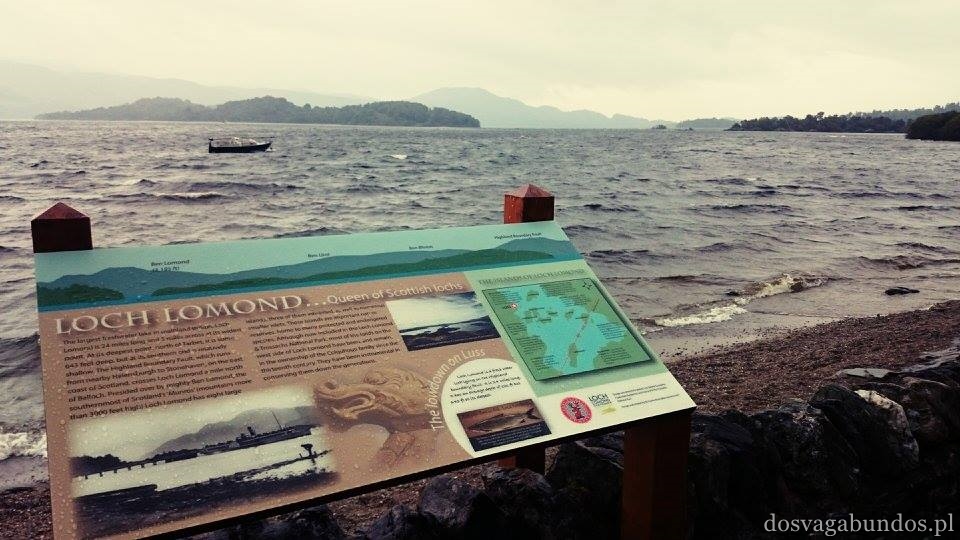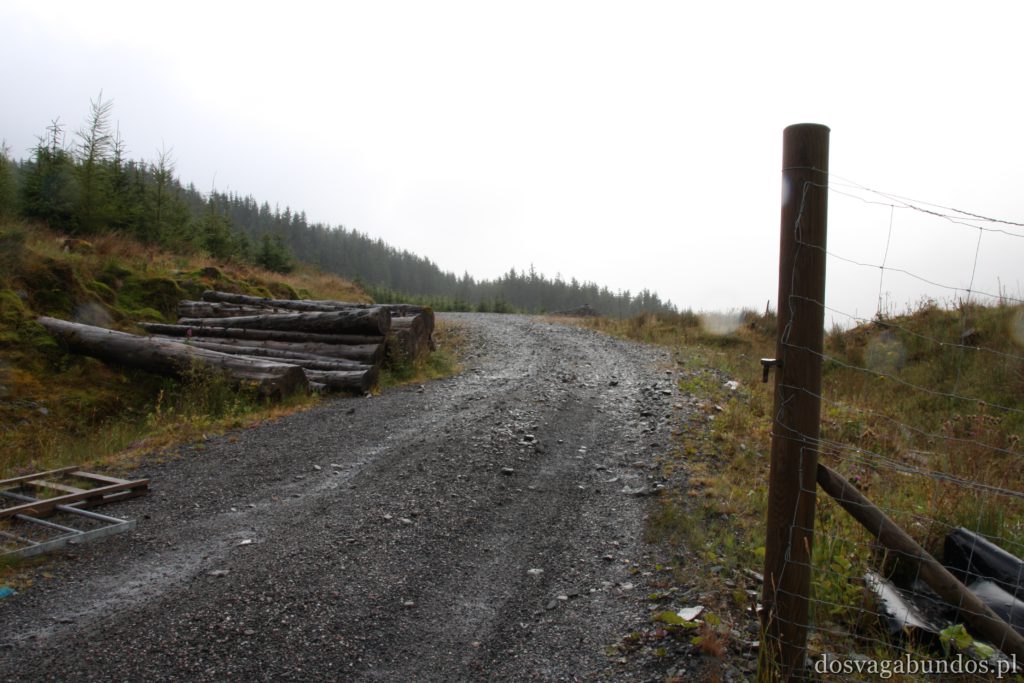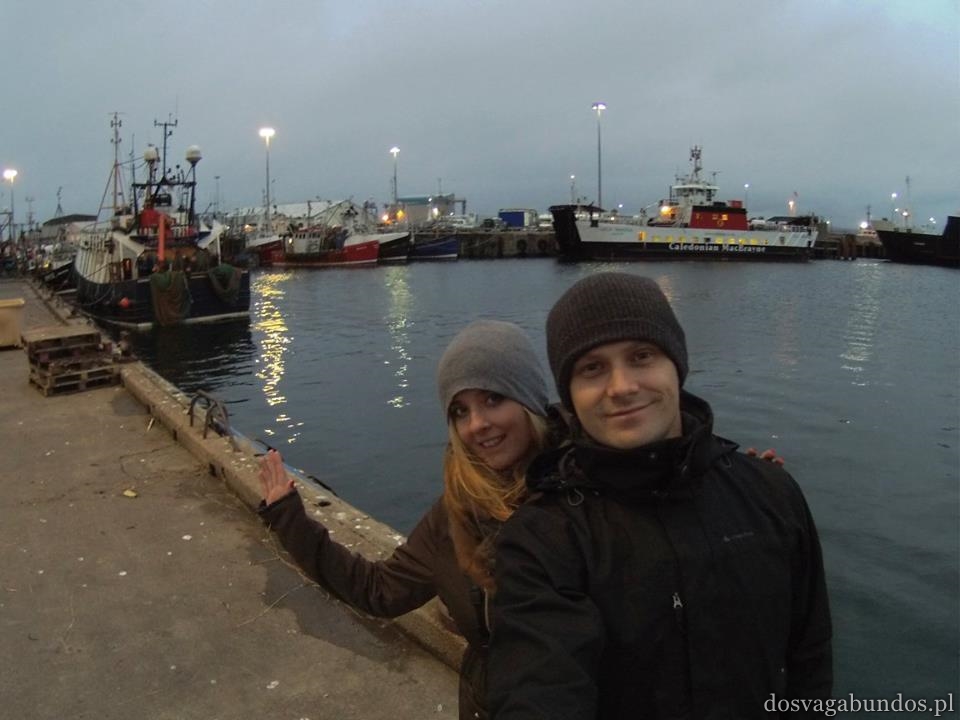Mallaig, liczące około 800 osób miasteczko portowe w zachodniej Szkocji. Niby nic wielkiego (dosłownie i w przenośni), a jednak coś sprawia, że w tamtejszym powietrzu czuje się magię. Niespieszne, o biało – niebieskich rysach, z kilkoma zajazdami gotowymi na przyjęcie turystów chcących przedostać się na Wyspę Skye. Oczywiście w mojej głowie jawiło się również jako idealne tło dla ekranizacji jakiegoś wciągającego kryminału i miewałam momenty roztaczania wizji uczestnictwa w wartkim śledztwie. Większość ludzi jednak, jak mniemam, będzie się w nim po prostu napawała błogim nicnierobieniem w oczekiwaniu na prom, który przedostanie ich ku dalszej części szkockiej podróży. Prowadząca doń trasa z Glasgow jest natomiast przeżyciem, które do końca życia zachowacie w głowie, w szufladce pt. “najpiękniejsze wspomnienia”.
Na sam koniuszek Highlandów ruszyliśmy z Glasgow. Biedny Sebek przeszedł niezły chrzest bojowy w przestawieniu się do jazdy z kierownicą po prawej stronie, ponieważ wystartowaliśmy w ścisłym centrum komercyjnej stolicy Szkocji. Oszukiwać nie będziemy – nastręcza to nieco problemów, zwłaszcza na rondach, więc jeśli jedziecie większą grupą, to żadne tam ciągnięcie zapałek – wybierzcie najlepszego kierowcę, żeby sprawnie ogarnął to wyzwanie. Za miastem sprawa jest znacznie prostsza, albowiem na niektórych odcinkach większości tras nie ma absolutnie nikogo i można jechać dziesiątki kilometrów prostą drogą, napotykając jedynie piękne widoki.
Naszym pierwszym przystankiem tej jednodniowej wycieczki było Luss nad Loch Lomond. Mimo iż zostaliśmy przywitani urwaniem chmury, zauroczyło nas bez reszty. Co więcej – okazało się, że takich miejsc mieliśmy na swojej trasie odwiedzić znacznie więcej. Ale uwaga, jest to dość zgubne dla turystów ograniczonych czasowo. Wysiadasz z samochodu i tylko czekasz, aż sympatyczna staruszka zaprosi Cię na kruche ciasteczka z konfiturą, a jej mąż drwal zaserwuje herbatę z prądem. Wchodzisz w ten sposób do Narni pełnej widoków przywodzących na myśl ilustracje z książek dla dzieci. I nagle okazuję się, że spędzasz tam zamiast 20 minut, 4 godziny, nie zdążasz na wykupiony prom i cały Twój misterny plan…Dlatego be aware. Odwiedzanie szkockich miasteczek grozi zagubieniem się w czasoprzestrzeni.
Z uwagi na powyższe taka pogoda nas w gruncie rzeczy ucieszyła – szybko ruszyliśmy w dalszą trasę, mając cichą nadzieję, że w końcu wyjdzie słońce i kolejne postoje będą bardziej owocne. Strategia okazała się połowicznie dobra, ponieważ gdy wysiadaliśmy celem zrobienia milionowego zdjęcia w jakiś 80% przypadków zbierały się nad nami chmury i moczyły po raz kolejny do suchej nitki, zupełnie jak w kreskówkach. Z drugiej zaś strony byliśmy zmuszeni do zrezygnowania z długiego zwiedzania, dzięki czemu wyrobiliśmy się mniej więcej z planem.
W kolejnym punkcie postoju, Inveraray, musieliśmy się zmagać z jeszcze bardziej sążnistym deszczem, dlatego bardzo dokładnie zwiedziliśmy lokalne punkty z whiskey oraz posililiśmy się pysznym fish & chips. Nieco jednak podłamani faktem, iż nie było nam dane wystarczająco dokładnie obejrzeć tego położonego w hrabstwie Argyll and Bute miasta królewskiego, a dokładnie jego imponującego zamku (ze względu na odbywającą się w nim imprezę z zaproszeniami) znowu dość szybko ruszyliśmy w dalszą trasę. I gdy prawie zaczęliśmy narzekać na niezrealizowanie planu zgodnie z założeniami, naszym oczom ukazał się widok jak z Alicji w Krainie Czarów. Otóż opuszczając miasto będziecie musieli wjechać na mały mostek. Gdy staniecie na jego szczycie, zobaczycie wspomniany zamek oraz otaczające go ogrody z takiej perspektywy, że wpadnie Wam natychmiast do głowy pomysł produkowania pocztówek na masową skalę. Legen- wait for it- dary view.
Rozanieleni ruszyliśmy dalej, nie mając pojęcia, że zobaczymy jeszcze to:
Trasę tę pokonywaliśmy mniej więcej w tempie kilometr na godzinę. No ale sami powiedzcie, czy da się nie wysiadać i nie uwieczniać takich widoków? No raczej, że nie. Oprócz krajobrazów nasza uwagę przykuwały też m.in. kolejne zamki lub ich ruiny, także żółw przegoniłby samochód 10 razy. Niestety nagle zaczęło się ściemniać, a my mieliśmy do “odhaczenia” jeszcze jeden punkt, więc docisnęliśmy gazu. Chcieliśmy zobaczyć Glenfinnan, a konkretnie położony nieopodal 21 przęsłowy wiadukt kolejowy, który w połączeniu z niesamowitą górską scenerią zachwyca do tego stopnia, że stał się plenerem kilku filmów. Ciekawe kto zgadnie jakich? Podpowiem tylko, że jeden opowiada o chłopcu z różdżka i w okrągłych okularach. Anyway. Więcej atrakcji, poza wzniesioną w 1815 roku wieżą, będącą pomnikiem Szkotów walczących w powstaniu Jakobitów, nie ma, także jakoś dużo czasu wyjątkowo nie trzeba sobie rezerwować. Najważniejsze jednak, że zaprzestaliśmy kompulsywnego robienia zdjęć, bo dotarlibyśmy do Mallaig w 2026 r.
Do punktu docelowego tej wycieczki dojechaliśmy na sam wieczór. Nasz hotel okazał się bardzo przytulnym lokum, ze skromnymi, acz czystymi pokojami, pachnącym drewnem i skórzanymi obiciami barem, miejscem kominkowym i głębokimi fotelami, w których można się było, trzymając w mapę z rozrysowanym planem na kolejne dni, błogo zatopić. Gdy wieczorem poszliśmy odwiedzić port, temperatura spadła do tego stopnia, że przywdzialiśmy zimowe kurtki i czapki, tak bardzo pizgało złem. Swoją drogą szkocka aura jest na tyle zmienna, że jednego dnia zasuwasz w cienkim t-shircie, by po 24h założyć puchówkę. Warto o tym pamiętać analizując potrzebę wykupienia bagażu do nadania. Staliśmy więc sobie okutani jak na Syberię w tym porcie i czuliśmy się absolutnie malutcy wobec bezkresu wody, jaki ukazał się naszym oczom. Rano z tego samego miejsca, wyruszyliśmy zaś promem na Wyspę Skye, ale o tym już w kolejnym poście.






















































Copper recovery services Copper scrap reclaiming Copper scrap yards
Copper chromate recycling Copper smelting process Copper recovery specialists
Copper component recycling Scrap Copper wire Copper scrap authenticity verification
Copper granules production Copper scrap resource conservation Copper recycling process
Metal waste compacting Ferrous material waste grading and sorting Iron salvage and recycling
Ferrous metal compliance, Iron waste management center, Scrap metal reprocessing facilities
Scrap metal sustainability Aluminium recycling process innovation Aluminum scrap sustainability
Scrap metal reclaiming depot, Aluminum cable scrap exporters, Scrap metal baling services
Metal scraps reprocessing Aluminium recycling market intelligence Aluminum scrap grades
Metal waste recycling center, Buying aluminum cable for scrap, Metal recovery and reprocessing
Industrial scrap metal recycling Aluminum scrap quality assurance Aluminum processing equipment
Metal recycling and reclamation center, Recycling aluminum wires and cables, Metal scrap dismantling
Scrap metal recovery and reclaiming Aluminium recycling process efficiency Aluminium scrap grading
Metal recycling and restoration, Scrap aluminum cable value, Scrap metal recovery and utilization
Metal waste recycling company Aluminum processing equipment Scrap aluminium weight measurement
Scrap metal regeneration, Aluminum cable scrap market analysis, Metal wastage
Scrap metal transportation regulations Ferrous material waste sharing Iron waste reutilization services
Ferrous material entrepreneurship, Iron recycling and recovery services, Logistics optimization for metal recycling
Metal scrap brokerage services Scrap aluminium repatriation Aluminium scrap collection
Metal waste refabrication, Aluminum cable insulation stripping, Metal waste processing tools
Sustainable Copper scrap recycling Copper scrap weight measurement Copper machining waste recycling
Metal reprocessing, Copper scrap purity standards, Metal treatment services
Economic benefits of Copper scrap recycling Copper poisoning is a rare condition that can occur when there is an excess buildup of copper in the body. While copper is essential for human health and is necessary for many bodily functions, too much of it can be toxic and lead to serious health problems. Here are some groups of people who may be at risk of harm from copper poisoning: 1. Individuals with Wilson’s Disease: Wilson’s disease is a genetic disorder that causes copper to build up in the body, especially in the liver and brain. This can result in liver damage, neurological problems, and psychiatric symptoms. Copper chelation therapy, which involves using medication to remove excess copper from the body, is often necessary to manage the condition. 2. People with Hemodialysis: Patients who undergo hemodialysis to manage kidney disease can be at risk of copper toxicity due to the use of copper-containing dialysate. Hemodialysis patients may also have an impaired ability to excrete excess copper from the body, making them more susceptible to copper accumulation. 3. Individuals with Excessive Copper Intake: Ingesting too much copper from dietary sources or supplements can lead to copper toxicity. This is not typically a problem for people who consume a balanced diet, but those who take high doses of copper supplements or who consume large amounts of copper-rich foods (such as organ meats or shellfish) may be at risk. 4. Infants and Children: Copper toxicity is more likely to occur in infants and young children due to their smaller size and developing organs. Excessive exposure to copper can lead to liver damage, gastrointestinal distress, and neurological problems in children. 5. Workers in Certain Industries: People who work in industries that involve the production or processing of copper (such as mining, smelting, or plumbing) may be at risk of occupational exposure to copper. This can lead to respiratory problems, gastrointestinal symptoms, or neurological problems. In conclusion, copper poisoning is a rare but serious condition that can affect individuals with certain medical conditions, those who ingest too much copper, or people who work in certain industries. If you suspect that you or someone you know may be experiencing copper toxicity, it is important to seek medical attention right away Metal waste reclamation facility Scrap copper trading Copper scrap industry partnerships Copper scrap trade regulations Copper scrap usage Metal scrap transportation logistics
Copper scrap regulations During the Roman and Medieval times, copper smelting was a major source of pollution that had a lasting impact on the environment and human health. This is evidenced by recent research that found traces of ancient copper smelting pollution in Greenland ice cores dating back to the 1st century AD. The study, published in the journal Environmental Science & Technology, analyzed ice cores from two locations in Greenland – the NorthGrip and NEEM sites. The ice cores contained layers of sulfur and copper pollution that could be traced back to specific periods of history. According to the study, copper smelting pollution was most prevalent during the Roman and Medieval periods. During these times, copper was a highly valued metal used in various industries, including coin minting, architecture, and weaponry. The smelting process involved heating copper ore, which produced large amounts of sulfur dioxide gas and other pollutants that were released into the air. These pollutants were carried by the wind and eventually settled in the ice sheets of Greenland. The study found that the levels of copper and sulfur pollution in the ice cores were highest during the Roman and Medieval periods, and then declined gradually over time. The impact of copper smelting pollution on the environment and human health was significant. The study notes that sulfur dioxide can cause respiratory problems, especially in those with pre-existing conditions such as asthma. Copper pollution can also lead to neurological and cardiovascular problems, as well as damage to the liver and kidneys. The study provides evidence that ancient copper smelting pollution had a lasting impact on the environment. The researchers note that the decline of copper smelting pollution in Greenland ice cores occurred around the time of the Industrial Revolution, which saw a shift towards cleaner energy sources and improved environmental practices. Overall, the study highlights the importance of understanding the historical impact of human activities on the environment, and the need to continue to strive towards sustainable practices and cleaner technologies Scrap metal brokerage Copper scrap purchasing tactics Copper stamping scrap purchase Copper scrap material reclamation Secondary copper sourcing Metal scrap processing
Electronic waste recycling Recycling yard management Iron scrap treatment
Ferrous material employee safety, Iron scrap salvage depot, Metal recycling and disposal
Metal waste removal Foundry ferrous metal recycling Iron scrap handling
Ferrous recycling facility, Iron salvage yard services, Metal cutting services
Scrap metal residue recycling Ferrous material regulatory reporting Iron scrap collection services
Ferrous material waste recycling technology, Iron waste reclamation facility, Scrap metal recovery solutions
Precious metal market dynamics Ferrous scrap industry analysis Iron waste reclaiming and recycling
Ferrous material agreements, Iron scrap processing machinery, Scrap metal business development
Efficient metal scrap handling Ferrous scrap salvage yard Iron material recycling
Ferrous waste reclaiming solutions, Iron scrap reclaiming processing, Metal waste refabrication